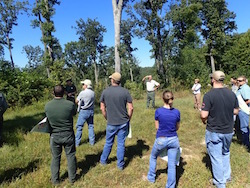By Kyle Aldinger, West Virginia RCPP Coordinator, National Wild Turkey Foundation
West Virginia has more forest cover (78%) and more Cerulean Warblers (36% of the global population) than any other state involved in the Cerulean Warbler Appalachian Forestland Enhancement Project. This means private landowners in the Mountain State, who own over 88% of the land, have a tremendous opportunity to enhance their woodlands to benefit this imperiled bird species and a number of other forest flora and fauna that use the same habitat. As with any new project, a critical early step is to reach out to these prospective participants. Hard-working partners including the Appalachian Mountains Joint Venture, USDA Natural Resources Conservation Service, WV Division of Forestry, WV Division of Natural Resources, National Wild Turkey Federation, and others collaborated on 73 outreach efforts over the past year and reached thousands of private landowners and natural resource professionals.
Overall, our efforts led to in-depth personal communications with 164 landowners across 82% of WV’s counties interested in getting involved in the project. After countless emails and phone calls, nearly 40 field visits, and 28 project applications, we ended year one with 437 acres under contract, obligating $69,910 for forestland enhancement. In addition, natural resource professionals that participated in outreach events took habitat management information and shared it with their respective organizations and private landowner contacts. This created a promotional cascade for sustainable forest management that led to such accomplishments as a 100-acre Cerulean Warbler public demonstration area at Sleepy Creek Wildlife Management Area.
Similarly as important are changing attitudes to such practices. Change is often a good thing! And changing attitudes don’t always have to converge on the same perspective. This is part of the reason why this project is so attractive and why many private landowners in West Virginia are considering getting involved. Whether objectives include ecosystem health, wildlife, forest products, recreation, aesthetics, a combination of these, or something else entirely, chances are with the help of biologists, foresters, and conservation planners, landowners may be able to develop a conservation plan that is compatible with Cerulean Warbler management guidelines. In West Virginia, we were fortunate to partner with an extensive network of private landowners fostered by the WV Division of Forestry and private consulting foresters through the Forest Stewardship Program. These landowners already with forest stewardship plans have a penchant for forest management and were the early adopters we needed to kick start the Cerulean Warbler project in year one.

West Virginians already enrolled in the project are preparing to take the historic step of being the first private landowners in the state to manage their woodlands as part of the Cerulean Warbler Appalachian Forestland Enhancement Project. The types of conservation practices to be implemented include commercial harvest (partial harvesting that allows the new forest stand to grow up under an open canopy of large trees), forest stand improvement (manipulating the forest stand structure and species composition to increase the quality of the stand), edge feathering (converting an abrupt forest edge into a gradual transition zone of shrubs, saplings, and vines), non-native invasive plant control, and tree planting. These practices add a level of structure and complexity to the habitat that is often missing from the typical deciduous forest stand, but is needed for Cerulean Warblers to thrive.
For the coming year, we are making changes based on what we have learned so far. These include a shift of the geographic focal area based on new data from the WV Division of Natural Resource’s recently completed 2nd WV Breeding Bird Atlas. While all counties will remain eligible for financial and technical assistance, a higher priority will be placed on counties in the Cumberland Mountains and Western Allegheny Plateau. This will allow us to focus conservation efforts where they are likely to have the largest benefit. We also plan to increase opportunities for landowners to get a hands-on glimpse at Cerulean Warbler habitat by organizing field tours of recently implemented projects on public and private land. Such tours are invaluable as they provide a deeper understanding of what Cerulean Warblers need and what it takes for a landowner to create such habitat.